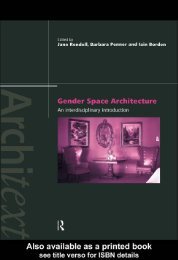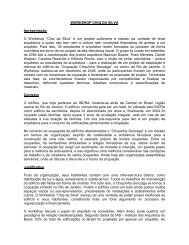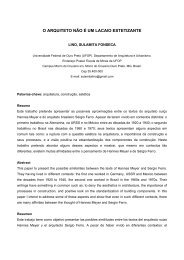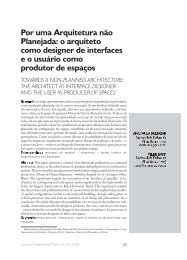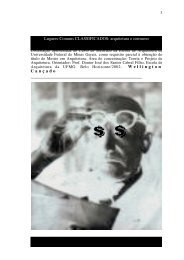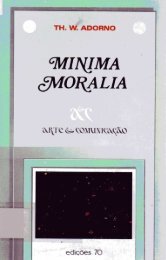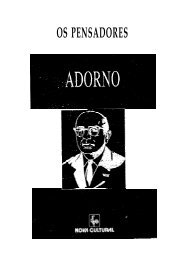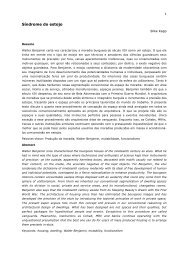in Peter blundell Jones, Doina Petrescu, Jeremy Till (eds.)
in Peter blundell Jones, Doina Petrescu, Jeremy Till (eds.)
in Peter blundell Jones, Doina Petrescu, Jeremy Till (eds.)
- No tags were found...
Create successful ePaper yourself
Turn your PDF publications into a flip-book with our unique Google optimized e-Paper software.
7998 wordsChapter 2The Negotiation of Hope<strong>Jeremy</strong> <strong>Till</strong>Fall<strong>in</strong>g on Deaf EarsIt is a w<strong>in</strong>ter night <strong>in</strong> 2003. I am attend<strong>in</strong>g a consultation session <strong>in</strong> a church hall <strong>in</strong> a blighted neighbourhoodthat has been designated as an NDC area. NDC – New Deal for Communities – is the Labour Government’slatest attempt at urban regeneration. It is a term that signals both past political failure and future hope. New.An acknowledgment that the old systems have not worked. Deal. A transaction; we give you money, you giveus back improvements. Communities. A wishful and wistful hope that fractured territories can bereconsolidated <strong>in</strong>to some semblance of community, without ever specify<strong>in</strong>g what that word may actuallymean.The title NDC also designates that the deal must be struck with the community; consultation and publicparticipation <strong>in</strong> the process are required. Hence the meet<strong>in</strong>g that I am attend<strong>in</strong>g. One year <strong>in</strong>to this particularNDC programme, and the community are show<strong>in</strong>g all the signs that the newness has rubbed off andconsultation fatigue has set <strong>in</strong>. The NDC officer is do<strong>in</strong>g a remarkable job <strong>in</strong> motivat<strong>in</strong>g some response out ofthe slumped bodies, the dropped shoulders, out of people numbed by years of failed promises.There is an architect’s scheme for a new community centre p<strong>in</strong>ned up at the back, scrawny draw<strong>in</strong>gs that noone can really see. A cursory discussion has taken place about the merits of the scheme, and now thecommunity is be<strong>in</strong>g asked to vote on it, a procedure statutorily required <strong>in</strong> this participation process. All buttwo hands go up. Quite on what grounds approval is be<strong>in</strong>g given is hard to tell. Maybe it is late and peoplewant to go home. Maybe they believe that a community hall will actually create a community. Maybe it is thepromise of church-hall tea after the vote. Maybe they love the architecture. Maybe the NDC officer hasswayed them. Maybe it is like a Mexican wave. Who knows? But this is the very stuff of participation.Architecture and Participation: Chapter 2: <strong>Till</strong>: Page 1
professional agents. One of the ma<strong>in</strong> advocates of architectural participation, Henry Sanoff, argues that:‘participants have a sense of <strong>in</strong>fluenc<strong>in</strong>g the design process….it is not so much the degree to which the<strong>in</strong>dividual ne<strong>eds</strong> have been met, but the feel<strong>in</strong>g of hav<strong>in</strong>g <strong>in</strong>fluenced the decisions’. x This is an explicitexample of placation, with the authority of the state replaced by the authority of the expert, and the citizenbeguiled by the term participation <strong>in</strong>to a sense of feel<strong>in</strong>g good whilst <strong>in</strong> fact be<strong>in</strong>g passive <strong>in</strong> the face ofdecisions already made by experts.Still worse is when this sooth<strong>in</strong>g gesture becomes downright manipulation – when the act of participation is <strong>in</strong>fact one of imposition under the false guise of <strong>in</strong>clusion. Take this sentiment from another US communitydesigner: ‘Community Designers should steer the decision mak<strong>in</strong>g process towards desired goals....designersmust function <strong>in</strong> communities both as <strong>in</strong>terpreters and as agents of change who challenge anti-urban values.’ xiWhilst this k<strong>in</strong>d of attitude may appear extreme, one suspects that it may <strong>in</strong> fact be quite ma<strong>in</strong>stream; the onlydifference is that Lozano has been honest (or stupid) enough to come clean. Normally the action is morecovert, a hidden persuasion. For example, <strong>in</strong> research as to what was most useful <strong>in</strong> a participatory process,some architects stated that the ‘problem’ (sic) of a participative meet<strong>in</strong>g was worth confront<strong>in</strong>g because of the‘<strong>in</strong>creased acceptability of the designer’, and that the f<strong>in</strong>al usefulness lay <strong>in</strong> ‘educat<strong>in</strong>g users’. xii Thesearchitects were prepared to engage <strong>in</strong> a participatory process simply to <strong>in</strong>crease their acceptability by asceptical public; this then allowed the architects to sneak their expert values through the back door. The wholeprocess thus left a predeterm<strong>in</strong>ed outcome unscathed by public op<strong>in</strong>ion .Carole Pateman labels such types of participation as ‘pseudo-participation …(this) covers techniques used topersuade employees to accept decisions that have already been made’. xiii Whilst her analysis is based onparticipation <strong>in</strong> the workplace, it is equally relevant to the architectural field, particularly when she describespseudo-participation as creat<strong>in</strong>g a ‘feel<strong>in</strong>g’ of participation. It may be argued that much of what passes forparticipation <strong>in</strong> architecture fits well <strong>in</strong>to the category of pseudo-participation; certa<strong>in</strong>ly the even<strong>in</strong>g meet<strong>in</strong>g<strong>in</strong> the Church Hall did.Architecture and Participation: Chapter 2: <strong>Till</strong>: Page 5
design process more open and explicit, computers also open the way for a wider range of participants tocontribute to the process…. <strong>in</strong> particular the users of the build<strong>in</strong>g, who have traditionally been allowed noparticipation <strong>in</strong> the design process, could become <strong>in</strong>volved <strong>in</strong> a computer-aided process’. xvii Key to this wasthe rise of the computer and numerical model<strong>in</strong>g which would, <strong>in</strong> Bill Mitchell’s hope, ‘result <strong>in</strong> an open<strong>in</strong>gup of architectural and urban design processes to a wider and truer participation by mak<strong>in</strong>g it possible fornon-specialists to comprehend and directly manipulate quite powerful models of the environment’. xviii In themost extreme version, Nicholas Negroponte’s Architecture Mach<strong>in</strong>e Group, the architect is supposedlydispensed with altogether as users develop their own build<strong>in</strong>g designs by direct <strong>in</strong>teraction with thecomputer. xixIn 1970 a group <strong>in</strong>clud<strong>in</strong>g Nigel Cross, Bill Mitchell and Nicholas Negroponte came together at a conferenceentitled Design Participation. Look<strong>in</strong>g through the papers it is difficult to identify much of what is nowperceived of as participation with<strong>in</strong> the slew of diagrams and technical data. What the diagrams reveal is aclarity of <strong>in</strong>tent on the designers’ part, and whilst the stated reason is that such clarity allows others to engagewith the process, the engagement is explicitly on the experts’ terms and therefore <strong>in</strong> thrall to them. The strongfeel<strong>in</strong>g is that participation, or rather pseudo-participation, is be<strong>in</strong>g used as a socially acceptable shield beh<strong>in</strong>dwhich the authors can develop their technically determ<strong>in</strong>ed ideologies. Reyner Banham, <strong>in</strong> his <strong>in</strong>troduction tothe conference, suggests as much when he writes: ‘When one looks down the list of speakers at thisconference and the titles of their papers, one wonders whether we have not got the same old DesignConference, but with the new wonder <strong>in</strong>gredient, “participation”…. some of us are putt<strong>in</strong>g our socialconsciences at work’. xx Banham, <strong>in</strong> identify<strong>in</strong>g the expediency of us<strong>in</strong>g participation as a screen, also notesthe impossibility of keep<strong>in</strong>g politics out of the participative mix. As organiser of the conference, Nigel Cross’orig<strong>in</strong>al aim was to look ‘for examples of new technologies and new techniques which might be sidestepp<strong>in</strong>gconventional political controls. That the conference seem<strong>in</strong>gly had to come round to discuss<strong>in</strong>g politics,suggests this may have been a fallacy.’ xxi By the end of the conference political issues had entered <strong>in</strong>to thedebate; they could not have been kept out. Participation is <strong>in</strong>herently political, not <strong>in</strong> the party political senseof the word, but <strong>in</strong> the sense that it affects people’s lives.Architecture and Participation: Chapter 2: <strong>Till</strong>: Page 7
The experience of the Design Conference is <strong>in</strong>dicative of the relationship between architecture andparticipation; one cannot suppress what ne<strong>eds</strong> to be there and yet architectural culture is <strong>in</strong> a state of denialabout many aspects of participation. The reason, as we shall see, is that participation presents a threat to manyof the central tenets of architecture and the profession does what it can (either know<strong>in</strong>gly or by default) toresist that threat. The denial of the political realm is one such mechanism by which that threat is suppressed.The threat may be expla<strong>in</strong>ed by the tension that exists between the ideals and the reality of architecturalpractice. Architects cl<strong>in</strong>g to a perfected model of practice, neatly and simplistically summarised <strong>in</strong> anidealised version of the Vitruvian triad – commodity, firmness and delight. Idealised commodity (solve the‘problem’ of function <strong>in</strong> as efficient a manner as possible). Idealised firmness (advance on technical fronts asa sign of progress). Idealised delight (a polish<strong>in</strong>g of forms <strong>in</strong> accordance with prevail<strong>in</strong>g aestheticsensibilities). The problem is when these ideals meet the reality of the cont<strong>in</strong>gent world; a threefoldunderm<strong>in</strong><strong>in</strong>g of the values of the ideals takes place. Cont<strong>in</strong>gent reality first upsets the carefully laid plans ofutility (users can be so annoy<strong>in</strong>gly unpredictable). Secondly it ignores many of the values held high byarchitectural culture (for example the public hardly share architects’ obsession with the ref<strong>in</strong>ed detail).Thirdly it br<strong>in</strong>gs <strong>in</strong>to play issues that are overlooked by the Vitruvian triad (most notably issues of the socialand political world). Disappo<strong>in</strong>tment, as Rem Koolhaas resignedly notes xxii , is <strong>in</strong>evitable <strong>in</strong> the face of thisunderm<strong>in</strong><strong>in</strong>g. And so the architect will do everyth<strong>in</strong>g possible to delay the fateful moment when reality bites.Suspension of disbelief is a condition of design practice. One knows <strong>in</strong> one’s heart of hearts that thesuspension cannot last, but the state is hypnotic whilst it does – those clean diagrams, those neatly scheduledpackages of work that defy all construction practice, those empty photographs taken before the greatunwashed (users, dirt, weather, change) move <strong>in</strong>. And when it all goes wrong afterwards, when reality trulydoes upset the ideals, one can always resort to the publication of a monograph to resuscitate and perpetuatethe mythology of a perfected state of architectural production.Participation br<strong>in</strong>gs forward the moment of reality and <strong>in</strong> so do<strong>in</strong>g <strong>in</strong>evitably challenges that suspension ofdisbelief. The participative process, as a signal of the reality to come, confronts architects with issues thatthey may otherwise have preferred to either hide from, or else delay deal<strong>in</strong>g with, for as long as possible.Architecture and Participation: Chapter 2: <strong>Till</strong>: Page 8
knowledge (because <strong>in</strong> the well-worn formulation reduced from Foucault, knowledge is power). As merefacilitators the architects are unable to re-imag<strong>in</strong>e their knowledge from the perspective of the user; theirknowledge is not used transformatively, rather their skills are used <strong>in</strong>strumentally. On the other hand, thetechnical know-how of the expert is not enough to help the users to develop new spatial visions; the user isgiven noth<strong>in</strong>g to enable them to expand on the their nascent but unarticulated desires, and so these rema<strong>in</strong> atthe level of the lowest common denom<strong>in</strong>ator, In Gillian Rose’s memorable phrase, ‘the architect is demoted;the people do not accede to power’. xxviThis <strong>in</strong>dicates that transformative participation cannot be achieved through the disavowal of expertknowledge. Nor is the solution to make the architect’s knowledge more accountable by mak<strong>in</strong>g it moretransparent. This is what the design methods movement proposed through open explication of the designprocess, but as we have seen this left the fram<strong>in</strong>g of the expert knowledge base unaltered. The non-expert isgranted easier access to the expert’s doma<strong>in</strong>, the gate to the ‘black box’ xxvii is opened wider, but the contentsrema<strong>in</strong> untouched. Instead a move towards transformative participation demands a reformulation of expertknowledge and the way it may be enacted.One of the def<strong>in</strong><strong>in</strong>g features of any profession is that it has its own knowledge base, and the more specialistthe knowledge base the ‘stronger’ – and more exclusive, better remunerated – the profession. In an attempt toestablish the <strong>in</strong>violate credentials of the profession, the architectural knowledge base, and its <strong>in</strong>scription <strong>in</strong>language and drawn codes, becomes more remote from the ne<strong>eds</strong> and comprehension of the users. Theparticipatory process br<strong>in</strong>gs the limits of architectural knowledge <strong>in</strong>to sharp focus; <strong>in</strong> its specialist pursuit oftechniques and aesthetics, architectural discourse detaches itself from the everyday desires and ne<strong>eds</strong> of thesocial lifeworld. A gap opens up between the special and the normal. In medic<strong>in</strong>e this gap is actuallynecessary <strong>in</strong> def<strong>in</strong><strong>in</strong>g the profession, because <strong>in</strong> treat<strong>in</strong>g the special (say a hole-<strong>in</strong>-the-heart) the expert doctorcan return the patient to the world of the normal. Indeed, the wider the gap, the more specialist the knowledgerequired, the stronger that aspect of the profession, the greater the remuneration; hence the perceived status ofthe heart surgeon over the general practitioner. In architecture, the participatory process reveals the gapbetween the special and the normal to be unacceptable, and yet architects will be wary of rel<strong>in</strong>quish<strong>in</strong>g theirArchitecture and Participation: Chapter 2: <strong>Till</strong>: Page 10
specialist areas of expertise because they believe this would threaten what sets them apart. There is thenagg<strong>in</strong>g doubt that <strong>in</strong> deal<strong>in</strong>g with the normal, us<strong>in</strong>g normal language, one might be seen as normal.Participation thus presents architects with a double b<strong>in</strong>d – the need to reassess what constitutes theirknowledge but also the worry that <strong>in</strong> so do<strong>in</strong>g one may no longer be seen as an architect. Best therefore toavoid the problem altogether, or at least to put it off for as long as possible. Architects thus tend to cl<strong>in</strong>g to thecerta<strong>in</strong>ty of what they know rather than expose themselves to the uncerta<strong>in</strong>ty of what others may know.The only way to get out of this b<strong>in</strong>d is to reconsider what constitutes the expert. This does not mean therel<strong>in</strong>quishment of knowledge but the redeployment of it <strong>in</strong> another mode. Experts feel most comfortable whenthe object of their scrut<strong>in</strong>y is abstracted, because then their specialist knowledge can be applied withoutdisturbance. However, this state of sharp but distanced focus is hard to reconcile with the reality of the spatial,social, world. In another context, the psychologist Roger Barker notes that ‘if we want to understand thefullness of baseball, we should not stare ourselves bl<strong>in</strong>d at the batter, but blot him out and look at hiscontext’. xxviii For architectural participation, this suggests that <strong>in</strong>stead of fixat<strong>in</strong>g on the build<strong>in</strong>g and user asobjects, we transfer our attention to their context. As Lerup says: ‘Our old exercise of star<strong>in</strong>g atobjects…fix<strong>in</strong>g them <strong>in</strong> our professional gaze, may be challenged by simply tak<strong>in</strong>g the position of the objectand see<strong>in</strong>g how people react to it’. xxixThis suggests that <strong>in</strong> order to enable transformative participation, architectural knowledge should not beapplied as an abstraction from the outside, but developed from with<strong>in</strong> the context of the given situation. This<strong>in</strong> turn calls for a new type of know<strong>in</strong>g. The profession is traditionally predicated on a know<strong>in</strong>g ‘how’ or aknow<strong>in</strong>g ‘that’, but at John Shotter argues <strong>in</strong> his important book, The Cultural Politics of Everyday Life, thesetypes of knowledge are ‘decontextualised’. Instead Shotter calls for a know<strong>in</strong>g ‘from with<strong>in</strong>’, a‘developmental’ knowledge that adjusts to and grows out of the social-cultural surround<strong>in</strong>gs <strong>in</strong> which it issituated. In Shotter’s terms, this is ‘know<strong>in</strong>g of the third k<strong>in</strong>d’ (unlike the first two know<strong>in</strong>g ‘how’ and‘that’). xxx To develop this knowledge from with<strong>in</strong>, the architect must project themselves <strong>in</strong>to the spatialcontext, physical and social, of the user; the architect becomes ‘an activist, work<strong>in</strong>g on behalf of and as adweller’. xxxi This is good advice; just as doctors <strong>in</strong> their brusque b<strong>eds</strong>ide manner often seem to forget that theyArchitecture and Participation: Chapter 2: <strong>Till</strong>: Page 11
was swept away by the waves, social life will f<strong>in</strong>d its way through the cracks <strong>in</strong> the wall of architecturaldenial, eventually overwhelm<strong>in</strong>g the hopeless purity of the forms with<strong>in</strong> - because those forms, conceived <strong>in</strong> apolitical vacuum, can put up no resistance. xliii Better then to take on board these contested territories earlierrather than be disappo<strong>in</strong>ted later. In this light participation should occupy a central position <strong>in</strong> architecturalpractice as opposed to sitt<strong>in</strong>g on the token marg<strong>in</strong>s where it tends to be found. Lars Lerup is clear about theopportunities that are afforded <strong>in</strong> the address<strong>in</strong>g of the political nature of space at an early stage. ‘The factrema<strong>in</strong>s that if dwellers and their designers take an active part <strong>in</strong> the negotiation of political space, new andbetter vistas will open up.’ xliv The key terms here are ‘negotiation’ (because that def<strong>in</strong>es the reality ofparticipation without be<strong>in</strong>g idealistic about reach<strong>in</strong>g consensus) and ‘new and better’ (because that sets theambition for participation to transcend pragmatics). Lerup goes on to say that if ‘negotiation dies, the hope forsplendid <strong>in</strong>habitation dies and most likely someone else other than dwellers will take over.’ This sets a newcontext for transformative participation as the negotiation of hope xlv – a potentially contested but ultimatelypositive process, both alert to the realities and posit<strong>in</strong>g a better future.The problem of the problemThe idea of the negotiation of hope sits uncomfortably with one of the normal premises of architecture,namely that it is a problem solv<strong>in</strong>g exercise; hope projects ambiguously forward, whereas problems lookdeterm<strong>in</strong>edly backwards. In education, the architectural studio is held up as an exemplar of problem-basedlearn<strong>in</strong>g, the space where students are set a ‘problem’ and through the creative, and reflective, act of designcome to a ‘solution’. In architectural practice the ‘problem’ is what gives the profession someth<strong>in</strong>g to actupon <strong>in</strong> a specialised manner. As Reyner Banham notes, ‘a professional is a man with an <strong>in</strong>terest, a cont<strong>in</strong>u<strong>in</strong>g<strong>in</strong>terest, <strong>in</strong> the existence of problems.’ xlvi Solv<strong>in</strong>g problems is how the profession legitimates itself; sett<strong>in</strong>gproblems is how it perpetuates itself.It is difficult to reconcile the notion of hope with that of problem solv<strong>in</strong>g. The negative connotation of theterm ‘problem’ casts a gloomy pall over the design process, imply<strong>in</strong>g that the best we can expect from thesolution is to make the world a less bad place, as opposed to the negotiation of hope which is founded on aArchitecture and Participation: Chapter 2: <strong>Till</strong>: Page 14
mutual aspiration to make the world a better place. John Chris <strong>Jones</strong> gets it just right when he says that ‘toth<strong>in</strong>k of design<strong>in</strong>g as “problem-solv<strong>in</strong>g” is to use a rather dead metaphor for a lively process and to forget thatdesign is not so much a matter of adjust<strong>in</strong>g to the status quo as of realiz<strong>in</strong>g new possibilities and discover<strong>in</strong>gour reactions to them.’ xlviiIf one problem with the problem is the way that it closes down the potential for new possibilities, the other isthat the fram<strong>in</strong>g and solv<strong>in</strong>g of the problem is an exclusionary act, and thus <strong>in</strong>appropriate for the terms oftransformative participation. Problems, as Banham <strong>in</strong>dicates, require a certa<strong>in</strong> type of professional, expert,knowledge to solve them. The identification of the problem thus <strong>in</strong>evitably privileges the expert over the user,limit<strong>in</strong>g the possibility of the negotiation of hope as a shared enterprise. We therefore need to f<strong>in</strong>d analternative paradigm for the design process. In an eloquent paper, the planner John Forester suggests that weshould replace the normative metaphor of design as the search for a solution with the idea of design as ‘sensemak<strong>in</strong>g’.‘Sense mak<strong>in</strong>g is not simply a matter of <strong>in</strong>strumental problem-solv<strong>in</strong>g, it is a matter of alter<strong>in</strong>g,respect<strong>in</strong>g, acknowledg<strong>in</strong>g, and shap<strong>in</strong>g people’s lived worlds.’ xlviii Central to Forester’s argument is that sucha move from the problem to sense-mak<strong>in</strong>g necessarily br<strong>in</strong>gs with it an acknowledgment of the contest<strong>eds</strong>ocial situation <strong>in</strong> which the design process is first <strong>in</strong>itiated and of the cont<strong>in</strong>gent social world <strong>in</strong> whichbuild<strong>in</strong>gs and their users will eventually be situated. Where problem solv<strong>in</strong>g, predicated as it is on positivistth<strong>in</strong>k<strong>in</strong>g, tends to either abstract or exclude the social and the political, sense-mak<strong>in</strong>g <strong>in</strong>evitably engages withthem and <strong>in</strong> so do<strong>in</strong>g accords with a model of participation <strong>in</strong> which social and political issues are brought tothe fore and then negotiated through spatial discussions. ‘If form giv<strong>in</strong>g is understood more deeply as anactivity of mak<strong>in</strong>g sense together, design<strong>in</strong>g may then be situated <strong>in</strong> a social world where mean<strong>in</strong>g, thoughoften multiple, ambiguous and conflict<strong>in</strong>g is nevertheless a perpetual practical accomplishment.’ xlixIt is Forester’s <strong>in</strong>sistence on mak<strong>in</strong>g sense together that resonates so powerfully with the idea oftransformative participation, and so it is worth follow<strong>in</strong>g through the implications of this approach. These arethreefold. The first we have already encountered; sense-mak<strong>in</strong>g leads to a reconsideration of what constitutesarchitectural knowledge. As opposed to the <strong>in</strong>strumentalist knowledge of problem solv<strong>in</strong>g, sense-mak<strong>in</strong>g isdeveloped through knowledge of the third k<strong>in</strong>d – knowledge from with<strong>in</strong> <strong>in</strong> which the participatory process isArchitecture and Participation: Chapter 2: <strong>Till</strong>: Page 15
founded on the will to achieve mutual understand<strong>in</strong>g. The second implication arises out of the first; <strong>in</strong> order toachieve this mutual understand<strong>in</strong>g one ne<strong>eds</strong> new models of communication. Thirdly, sense-mak<strong>in</strong>g br<strong>in</strong>gswith it uncerta<strong>in</strong>ty and imprecision that demand the participants face up to the very cont<strong>in</strong>gency ofarchitectural practice. It is to these last two issues, communication and cont<strong>in</strong>gency, that we now turn.Urban Storytell<strong>in</strong>g‘Doctr<strong>in</strong>es must take their beg<strong>in</strong>n<strong>in</strong>gs from that of the matter which they treat’. VicoThere is always the nagg<strong>in</strong>g, but quite serious, concern that conventional methods of architecturalcommunication are describ<strong>in</strong>g someth<strong>in</strong>g that is <strong>in</strong> fact not architecture. Draw<strong>in</strong>gs can never describe thefullness of the future occupation of space; they are, of course, radically reductive. As Rob<strong>in</strong> Evans argues sobrilliantly <strong>in</strong> The Projective Cast, this representational reduction is not necessarily a problem as long as oneacknowledges the role of the architectural imag<strong>in</strong>ation <strong>in</strong> achiev<strong>in</strong>g the translation from draw<strong>in</strong>g to build<strong>in</strong>g. lThe alchemy of imag<strong>in</strong>ation is a second means by which the architect achieves professional closure; specialisttechnical knowledge with <strong>in</strong>def<strong>in</strong>able creativity is the comb<strong>in</strong>ation that establishes architecture apart fromother vocations that might have one aspect but not the other. However, <strong>in</strong> the context of participation thearchitectural imag<strong>in</strong>ation presents a problem, <strong>in</strong> so much as it is an <strong>in</strong>ternalized impulse and thus not availablefor mutual understand<strong>in</strong>g with the other participants. Draw<strong>in</strong>gs, which for the architect may be pregnant withpossibilities, rema<strong>in</strong> mute to the outsider. The exclusion is re<strong>in</strong>forced by the technical nature of so mucharchitectural discourse. liIn order to achieve transformative participation, it is therefore necessary to look for a new model ofcommunication. The clue as to what this may be lies <strong>in</strong> the nature of the knowledge at stake and the makeupof the participants. ‘New knowledge neither grows out of a special method, not the special m<strong>in</strong>d of a geniusnor from new theoretical monologues… but from the voices of ord<strong>in</strong>ary people <strong>in</strong> conversation.’ lii Whereprofessional knowledge tends to reaffirm the status quo, or to <strong>in</strong>crementally shift it, the knowledge conta<strong>in</strong>ed<strong>in</strong> the conversations of ord<strong>in</strong>ary people, of participants, conta<strong>in</strong> the germs of new spatial possibilities. Thetrick is how to recognise this, how to identify the ‘real possibilities present <strong>in</strong> those fleet<strong>in</strong>g, extraord<strong>in</strong>ary,Architecture and Participation: Chapter 2: <strong>Till</strong>: Page 16
non-professional moments of <strong>in</strong>determ<strong>in</strong>acy, undecidability and ambivalence’. liii The key lies <strong>in</strong> recognis<strong>in</strong>gthe power and validity of ord<strong>in</strong>ary conversation as a start<strong>in</strong>g po<strong>in</strong>t for the participatory process. Of course thischallenges normative patterns of professional and academic legitimacy. Both of these sets of discourse areoften predicated on the pr<strong>in</strong>ciples of logic and completeness, liv aga<strong>in</strong>st which measures the openness oford<strong>in</strong>ary conversation is seen as a lower form of communication, and thus one capable of be<strong>in</strong>g dismissed.However, this overlooks the potentials to be found <strong>in</strong> everyday conversation which ‘conta<strong>in</strong>s morepossibilities for our future development than we ever before imag<strong>in</strong>ed.’ lvWhat is suggested here is the appropriateness of conversation to the architectural participatory process. First,conversation moves the architect from be<strong>in</strong>g a detached observer <strong>in</strong>to an engaged participant, enabl<strong>in</strong>g him orher to see from with<strong>in</strong> a given situation. Second, it anticipates the future spatial possibilities <strong>in</strong> terms of timeand occupation rather than see<strong>in</strong>g them as fixed and empty forms. Thirdly, conversations br<strong>in</strong>g <strong>in</strong>to playsocial relationships because, as Rom Harré notes, the primary human reality is <strong>in</strong> persons <strong>in</strong> conversation. lviFourthly, conversations <strong>in</strong> their open-ended nature give rise to unexpected consequences; they may lead theparticipants down paths that they may have never found through logic. In all these four ways conversationscan actually describe what architecture may be, namely the temporal, cont<strong>in</strong>gent, social occupation of space -a world undiscovered <strong>in</strong> the reductive draw<strong>in</strong>g. If we follow Vico’s urg<strong>in</strong>g that ‘doctr<strong>in</strong>es must take theirbeg<strong>in</strong>n<strong>in</strong>gs from that of the matter which they treat’, lvii then ord<strong>in</strong>ary conversations can form the perfect startto architectural production. What the participatory process does is to provide a context for those conversationsto be <strong>in</strong>itiated – and once aga<strong>in</strong> participation is here a catalyst for new ways of look<strong>in</strong>g at architecturalpractice, expos<strong>in</strong>g the limits of normative architectural methods.‘Conversations’ is maybe too vague a term, and also it does not necessarily avoid the imbalance of authorityfound <strong>in</strong> most participatory processes. A more equitable and focused conversational mode is found <strong>in</strong>storytell<strong>in</strong>g. ‘The very act of storytell<strong>in</strong>g, an act that presumes <strong>in</strong> its <strong>in</strong>terlocutor an equality of <strong>in</strong>telligencerather than an <strong>in</strong>equality of knowledge, posits equality, just as the act of explication posits <strong>in</strong>equality.’ lviii Theauthoritative positivist explanation of the expert (‘You should have your front door here because it is closestto the road’) is replaced by the suggestive and imag<strong>in</strong>ative storyl<strong>in</strong>e of the potential dweller (‘..we ran throughArchitecture and Participation: Chapter 2: <strong>Till</strong>: Page 17
the back door, steam<strong>in</strong>g bodies <strong>in</strong>to air dense with chip fat.’). All of us have stories with<strong>in</strong> us, be theydescriptive of the past, fictional for the future, anecdotal or practical. Stories have with<strong>in</strong> them elements thatare both personal and social, they become a means of describ<strong>in</strong>g one’s place <strong>in</strong> the world, of locat<strong>in</strong>g the<strong>in</strong>dividual with<strong>in</strong> shared spaces. Stories are the place where the imag<strong>in</strong>ation f<strong>in</strong>ds l<strong>in</strong>es of flight. If one starts aparticipatory process through a ‘what if?’ question, and then develops the answers through the forms ofstories, two th<strong>in</strong>gs happen. First the stories arise out of experience of the world and thus have a ground<strong>in</strong>g <strong>in</strong>reality; secondly the ‘what if?’ allows stories to imag<strong>in</strong>e and to project new spatial visions. lix Stories thusbecome conduits for the negotiation of hope, but because of their found<strong>in</strong>g <strong>in</strong> everyday experience that hopeis not impossibly idealistic. Too often hope is associated with unachievable utopias, and participation isfounded on idealistic notions of consensus; stories avoid such delusions whilst at the same time not shutt<strong>in</strong>gdown possibilities and opportunities. The role of the architect becomes to understand and draw out the spatialimplications of the urban storytell<strong>in</strong>g. This role requires both knowledge and imag<strong>in</strong>ation, but <strong>in</strong> both casesthese attributes are externalized and shared, rather than be<strong>in</strong>g <strong>in</strong>ternalised and exclusive as happens <strong>in</strong> nonparticipatorypractice. The architect, as negotiator of hope <strong>in</strong>itiated through urban storytell<strong>in</strong>g, thus is muchmore than a mere technical facilitator but at the same time is not tarnished with the brush of unfettered power.Mak<strong>in</strong>g Best SenseIf one develops the participatory process out of the strength of storytell<strong>in</strong>g, then these conversations br<strong>in</strong>gwith them uncerta<strong>in</strong>ty; they br<strong>in</strong>g cont<strong>in</strong>gency <strong>in</strong>to the process. So many architectural values are founded onthe banishment of cont<strong>in</strong>gency, lx that to be confronted with cont<strong>in</strong>gency at the start of the design processrepresents a serious disturbance to purist architectural production. Aga<strong>in</strong>, we see how participation, bybr<strong>in</strong>g<strong>in</strong>g forward what is otherwise denied or delayed, presents a ‘threat’.In order to understand how participation, <strong>in</strong> deal<strong>in</strong>g with cont<strong>in</strong>gency, actually offers an opportunity ratherthan a threat, we need to return to John Forester’s notion of design as mak<strong>in</strong>g-sense-together, and <strong>in</strong> particularto the ambiguous and complex conditions that such an approach throws up. lxi The question rema<strong>in</strong>s, however,as to what type of sense we are mak<strong>in</strong>g. The most obvious and sooth<strong>in</strong>g answer is that we are mak<strong>in</strong>gArchitecture and Participation: Chapter 2: <strong>Till</strong>: Page 18
common sense – that the process of participation leads to a sense of shared, ‘sensible’, values. But the notionof common sense is compromised. On the one hand it suggests that solutions will be arrived at <strong>in</strong> anunth<strong>in</strong>k<strong>in</strong>g, uncontested manner. lxii Small wonder that the Conservative Party used the slogan ‘Time forCommon Sense’ as the title of their 2001 Election Manifesto, as if they could pass off their deeply ideologicalagenda under the guise of ‘straightforward’ Middle-England saloon bar logic. Common sense is alsoproblematic <strong>in</strong>tellectually. The very proposition that sense can be arrived at through commonly agreedpr<strong>in</strong>ciples presupposes that universal structures of thought can be erected, lxiii and with these universalsolutions can be found. In the context of participation, such universal structures clearly suppress thedevelopment of particular desires. In addition, by identify<strong>in</strong>g common sense with the realm of the detached<strong>in</strong>tellect, one removes it from the social world; common sense <strong>in</strong> this light becomes formal and prescriptiverather than social and cultural. lxivTherefore <strong>in</strong>stead of see<strong>in</strong>g participation as the move towards the establishment of common sense, it may bebetter to posit it <strong>in</strong> terms of mak<strong>in</strong>g best sense. The philosopher Charles Taylor argues that best sense aims‘not an absolute best but a partial best…(it offers) the more realistic orientation about the good, but alsoallows us to best understand and make sense of the actions of others’. lxv The idea of mak<strong>in</strong>g best sense thusacknowledges three th<strong>in</strong>gs: first that that no one perfect solution exists; secondly, that others are <strong>in</strong>volved <strong>in</strong>the process, it is not the work of the lone <strong>in</strong>tellect or expert; thirdly, and crucially, it identifies the verycont<strong>in</strong>gency of architectural practice. Architecture is open to forces beyond the direct control of the architect.In participation, this cont<strong>in</strong>gency is represented first through the desires of the users, and the architect has toface up to the often conflict<strong>in</strong>g status of these desires. It is not matter of attempt<strong>in</strong>g to f<strong>in</strong>d a consensus amongthese compet<strong>in</strong>g positions, but of us<strong>in</strong>g one’s judgment to make best sense of them. The process, whilstpotentially lead<strong>in</strong>g to un<strong>in</strong>tended consequences, thus still has <strong>in</strong>tentionality. lxvi This <strong>in</strong>evitably leads to theacceptance of difference rather than the imposition of a false equality, even if this might grate with acceptedliberal norms of participation, <strong>in</strong> which the search for a solution acceptable to all is paramount. The spacesaris<strong>in</strong>g out of the cont<strong>in</strong>gency of participation are thus not necessarily those of static harmony, but ‘a commonspace that is also a fissured space is not an oxymoron’. lxvii Instead a different notion of equality arises, not onebased on pr<strong>in</strong>ciples of absolute universality, but one which ‘as a cont<strong>in</strong>gent outcome of a conflicts andArchitecture and Participation: Chapter 2: <strong>Till</strong>: Page 19
strategic calculation is a sedimented moment <strong>in</strong> a fluctuat<strong>in</strong>g equilibrium’. lxviii The hope, therefore, is that aparticipatory process that is based on the pr<strong>in</strong>ciple of mak<strong>in</strong>g the best sense will lead to architecture capableof accept<strong>in</strong>g difference and architecture that is responsive to change over time, s<strong>in</strong>ce it avoids the stasis of anyuniversaliz<strong>in</strong>g tendency.The Negotiation of HopeIn this chapter I have attempted to formulate an approach to participation that moves beyond the token<strong>in</strong>volvement of users towards a more transformative model. In order for this to happen, architects need toaccept changes to the standard methods and values of practice, and <strong>in</strong> particular to see that the issues thatparticipation br<strong>in</strong>gs to the fore present not a threat but an opportunity, lead<strong>in</strong>g to a more empower<strong>in</strong>g form ofarchitecture. This is a achieved through an acceptance – or let’s hope a welcom<strong>in</strong>g – of the political aspects ofspace, of the vagaries of the lives of users, of different modes of communication and representation, of anexpanded def<strong>in</strong>ition of architectural knowledge and of the <strong>in</strong>escapable cont<strong>in</strong>gency of practice. Thisacceptance leads not only to a revitalised, and more relevant, form of participatory practice, but also to arevitalised, and more relevant, form of architectural practice. For too long architecture has isolated itself <strong>in</strong> theva<strong>in</strong> pursuit of the <strong>in</strong>compatible bedfellows, <strong>in</strong>novation and timelessness. Participation challenges thesevalues and br<strong>in</strong>gs an awaken<strong>in</strong>g of the virtues of engagement, an awaken<strong>in</strong>g that might come as a shock toarchitects more used to a deluded detachment, but an awaken<strong>in</strong>g that is necessary if architecture is to have anyfuture relevance.Participation is not a worthy sop to our political masters; it is not an excuse for mediocrity; it is not distractionfrom supposedly higher values. Participation is the space <strong>in</strong> which hope is negotiated. What is clear is that thishope refers not just to a better future for the users of the built environment, but also to a better future forarchitectural practice.Architecture and Participation: Chapter 2: <strong>Till</strong>: Page 20
i For sources of participative noise see B. Wisner, 'Participatory and Action Research', <strong>in</strong>. E. Zube and G. Moore (<strong>eds</strong>.),Advances <strong>in</strong> Environment, Behaviour and Design, New York: Plenum, 1991, p. 280.ii The literature on plann<strong>in</strong>g and participation is very extensive, far more so than on architecture. Some of the key textsare: J. Friedmann, Retrack<strong>in</strong>g America; a Theory of Transactive Plann<strong>in</strong>g, Garden City: Anchor Press, 1973.; J. Forester,Plann<strong>in</strong>g <strong>in</strong> the Face of Power, Berkeley: University of California Press, 1989.; P. Healey, Collaborative Plann<strong>in</strong>g :Shap<strong>in</strong>g Places <strong>in</strong> Fragmented Societies, Vancouver: UBC Press, 1997. For a full bibliography on plann<strong>in</strong>g andparticipation, see Richardson and Connelly <strong>in</strong> this book.iii Taken from a longer table <strong>in</strong> Wisner, 'Participatory and Action Research', p. 277.iv S. Arnste<strong>in</strong>, 'The Ladder of Citizen Participation', Journal of the Institute of American Planners, 34, no. 4, 1969. Theladder is, from the bottom: manipulation-therapy-<strong>in</strong>form<strong>in</strong>g-consultation-placation-partnership-delegated power-citizencontrolv C. Pateman, Participation and Democratic Theory, Cambridge: Cambridge University Press, 1970.vi Ibid., p. 25.vii Ibid., p. 27.viii Ibid., p. 7.ix Ibid., p. 13.x H. Sanoff, 'The Application of Participatory Methods <strong>in</strong> Design and Evaluation', Design Studies, 6, no. 4, 1985. Myitalics.xi E. E. Lozano, Community Design and the Culture of Cities, Cambridge: Cambridge University Press, 1990.xii J. Watts and M. Hirst, 'User Participation <strong>in</strong> the Early Stages of Build<strong>in</strong>g Design', Design Studies, 3, no. 1, 1982, p. 17.xiii Pateman, Participation and Democratic Theory, p. 68.xiv Ibid., p. 71.xv This term draws on the notion of transformative theory developed by the plann<strong>in</strong>g theorist, John Friedmann. See J.Friedmann, Plann<strong>in</strong>g <strong>in</strong> the Public Doma<strong>in</strong> : From Knowledge to Action, Pr<strong>in</strong>ceton: Pr<strong>in</strong>ceton University Press, 1987.xvi Apart from the Design Conference group<strong>in</strong>g which <strong>in</strong>cludes Nigel Cross, Bill Mitchell and Nicholas Negroponte, it isalso <strong>in</strong>terest<strong>in</strong>g to note that many participation advocates such as Henry Sanoff came out of a design methods background.xvii see N. Cross, The Automated Architect, London: Pion, 1977, p. 123.xviii R. Banham, 'Open<strong>in</strong>g Remarks', <strong>in</strong>. N. Cross (ed.), Design Participation, London: Academy Editions, 1972.Architecture and Participation: Chapter 2: <strong>Till</strong>: Page 21
xix See Cross, The Automated Architect, p. 124. It might appear that this group<strong>in</strong>g were dazzled by the white heat oftechnology of their 8-bit computers, but these sentiments still pervade. In a recent book on the subject opens with:’(Our)new perspective is that technical optimization and social optimization should not be carried out separately, but be<strong>in</strong>tegrated <strong>in</strong>to one design process’. The essential skills of urban designers and architects should <strong>in</strong>clude skills <strong>in</strong>numerical computer model<strong>in</strong>g. However, the real aim of this approach is revealed when the authors refer to ‘persuasion bynumerical and geometrical model<strong>in</strong>g’. See L. v. Gunsteren and P.-P. v. Loon, Open Design: A Collaborative Approach toArchitecture, Delft: Eburon, 2000, p. v.xx Banham, 'Open<strong>in</strong>g Remarks'.xxi N. Cross, Design Participation, London: Academy Editions, 1972, p. 14.xxii Koolhaas def<strong>in</strong>es the three stages of practice as elation, suspense, disappo<strong>in</strong>tment.xxiii Lefebvre is clear <strong>in</strong> identify<strong>in</strong>g the problem of the word ‘user’, which tends to denote the user as some k<strong>in</strong>d offunctional object, subject to architectural manipulation. See H. Lefebvre, The Production of Space, trans. D. Nicholson-Smith, Oxford: Blackwell, 1991. However, user is probably the most commonly employed term <strong>in</strong> architecturalparticipation and identifies a different category from the client. Real participation must engage the user over and above theclient, whose priorities are so often similar to those of the architect.xxiv For a critique of this approach, see: M. Crawford, 'Can Architects Be Socially Responsible?' <strong>in</strong>. D. Y. Ghirardo (ed.),Out of Site : A Social Criticism of Architecture, Seattle: Bay Press, 1991. For justification of it: N. Wates and C. Knevitt,Community Architecture : How People Are Creat<strong>in</strong>g Their Own Environment, London: Pengu<strong>in</strong>, 1987.xxv L. Lerup, Build<strong>in</strong>g the Unf<strong>in</strong>ished : Architecture and Human Action, Beverly Hills: Sage, 1977, p. 136.xxvi G. Rose, 'Athens and Jerusalem: A Tale of Two Cities', Social and Legal Studies, 3, 1994, p. 337. For a developmentof this argument see J. <strong>Till</strong>, 'Architecture of the Impure Community', <strong>in</strong>. J. Hill (ed.), Occupy<strong>in</strong>g Architecture : Betweenthe Architect and the User, London: Routledge, 1998.xxvii This is Reyner Banham’s term to describe the conta<strong>in</strong>er that houses the self-referential world of architecture. R.Banham, 'A Black Box: The Secret Profession of Architecture', <strong>in</strong>. M. Banham (ed.), A Critic Writes, Berkeley: Universityof California Press, 1996.xxviii Roger Barker, Ecological Psychology, p16 as quoted <strong>in</strong> Lerup, Build<strong>in</strong>g, p. 156.xxix Ibid.xxx J. Shotter, Cultural Politics of Everyday Life : Social Constructionism, Rhetoric and Know<strong>in</strong>g of the Third K<strong>in</strong>d,Buck<strong>in</strong>gham: Open University Press, 1993, p. xiii. The terms ‘know<strong>in</strong>g how’ and ‘know<strong>in</strong>g what’ are <strong>in</strong>itially from G.Ryle, The Concept of M<strong>in</strong>d, New York: Barnes & Noble, 1962.xxxi Lerup, Build<strong>in</strong>g, p. 136.Architecture and Participation: Chapter 2: <strong>Till</strong>: Page 22
xxxii In a parallel discussion of <strong>in</strong>tellectuals and their relationship to ideologies, Michael Billig et al make the dist<strong>in</strong>ctionbetween <strong>in</strong>tellectual and lived ideologies, the first of which is characterized by be<strong>in</strong>g formalised and systematic, the latterof which refers to a non-formalised notion aris<strong>in</strong>g out of society’s way of life. Architects, and other professionals, tendtowards the former but cannot escape the latter because, as Billig argues, ‘every great theorist has to confront the conflictbetween the lived and <strong>in</strong>tellectual ideologies – because they also have to live out their lives as citizens’. M. Billig,Ideological Dilemmas : A Social Psychology of Everyday Th<strong>in</strong>k<strong>in</strong>g, London: Sage, 1988, p. 32.xxxiii ‘Each man, outside his professional life carries on some form of <strong>in</strong>tellectual activity…has a conscious l<strong>in</strong>e of moralconduct and this contributes to susta<strong>in</strong><strong>in</strong>g a conception of the world or to modify<strong>in</strong>g it, that is to br<strong>in</strong>g <strong>in</strong>to be<strong>in</strong>g newmodes of thought’. A. Gramsci, Selections from the Prison Notebooks of Antonio Gramsci, trans. Q. Hoare and G.Nowell-Smith, London: Lawrence & Wishart, 1971, p. 10.xxxiv C. Boggs, Gramsci's Marxism, London: Pluto Press, 1976, p. 77.xxxv Gramsci, Selections from the Prison Notebooks of Antonio Gramsci, pp. 7-23.xxxvi see Pateman, Participation and Democratic Theory, p. 68.xxxvii For a development of this see Friedmann, Retrack<strong>in</strong>g America; a Theory of Transactive Plann<strong>in</strong>g, pp. 109-11.xxxviii Sanoff, 'The Application of Participatory Methods <strong>in</strong> Design and Evaluation'.xxxix In this context it is <strong>in</strong>terest<strong>in</strong>g to note that <strong>in</strong> Habermas’ theory of communicative action, it is his argument for an‘ideal speech situation’ that has drawn the most fire. His critics accuse him of seem<strong>in</strong>g naivety <strong>in</strong> even posit<strong>in</strong>g thepossibility of authentic speech, his defenders note that people act, and need to act, as if the possibility of ideal speech wasachievable.xl J. Albrecht, 'Towards a Theory of Participation <strong>in</strong> Architecture', Journal of Architectural Education, 42, no. 1, 1998.xli There is not the space to develop the argument here, but it is neatly summarised by the French architect Jean Renaudiewho writes: ‘The stubborn refusal of some people to admit to the <strong>in</strong>fluence of politics on architecture, and the narrowassertion of others that architecture is politics and noth<strong>in</strong>g else, result <strong>in</strong> the same th<strong>in</strong>g: <strong>in</strong>efficiency <strong>in</strong> practice.’' The keytext <strong>in</strong> the recent reawaken<strong>in</strong>g of the political dimension of space must be Lefebvre, The Production of Space.xlii M. Comerio, 'Community Design: Idealism and Entrepreneurship', Journal of Architectural & Plann<strong>in</strong>g Research, 1,no. 4, 1984.. See Blundell <strong>Jones</strong>’ chapter <strong>in</strong> this book for the story of the sixties.xliii Koolhaas’ pithy rem<strong>in</strong>der is apt here. ‘Once we were mak<strong>in</strong>g sandcastles. Now we swim <strong>in</strong> the sea that swept themaway.’ R. Koolhaas and B. Mau, S,M,L, Xl, Rotterdam: 010 Publishers, 1995, p. 971. The problem is his ambivalence <strong>in</strong>how to deal with the condition. See J. <strong>Till</strong>, ‘An Incomplete Encyclopedia: Rem Koolhaas and S,M,L,Xl’, Artifice, March1996.xliv Lerup, Build<strong>in</strong>g, p. 30.Architecture and Participation: Chapter 2: <strong>Till</strong>: Page 23
xlv I take this formulation from the title of Howell Baum’s book The Organisation of Hope, which <strong>in</strong> turn comes from adescription used by a plann<strong>in</strong>g student Stephen Blum. See H. S. Baum, The Organization of Hope : CommunitiesPlann<strong>in</strong>g Themselves, Albany, NY: State University of New York Press, 1997. The word ‘organisation’ is maybe too<strong>in</strong>strumental for participation, hence my replacement with ‘negotiation’.xlvi Banham, 'Open<strong>in</strong>g Remarks'.xlvii J. C. <strong>Jones</strong>, Design Methods, 2nd ed., New York: Van Nostrand Re<strong>in</strong>hold, 1992, p. xxix.xlviii J. Forester, 'Design<strong>in</strong>g: Mak<strong>in</strong>g Sense Together <strong>in</strong> Practical Conversations', Journal of Architectural Education, 38,no. 3, 1985. See also Forester, Plann<strong>in</strong>g <strong>in</strong> the Face of Power, pp. 119-33.xlix Forester, 'Design<strong>in</strong>g', p. 14.l R. Evans, The Projective Cast : Architecture and Its Three Geometries, Cambridge, Mass.: MIT Press, 1995.li Hav<strong>in</strong>g sat on many <strong>in</strong>terview panels to select architects for community-based projects, I am cont<strong>in</strong>ually astounded atthe language that most architects choose to use. Jargon and technical term<strong>in</strong>ology, together with nods to me as thesupposed expert, do noth<strong>in</strong>g but alienate, and confuse, the eventual users. These architects do not get the job.lii Billig, Ideological Dilemmas, p. 162.liii Shotter, Cultural Politics, p. 52.liv see Ibid., p. 141. Much post modern academic discourse may be seen to challenge notions of logic, but still work outfrom it as a pr<strong>in</strong>ciple.lv Ibid., p. 39.lvi Ibid., p. 128.. The same po<strong>in</strong>t is made by John Forester: ‘Design as sense-mak<strong>in</strong>g via conversation situates thedesigner’s work <strong>in</strong> a historical, practical context’. Forester, 'Design<strong>in</strong>g', p. 17.lvii G. Vico, The New Science of Giambattista Vico, trans. T. Berg<strong>in</strong> and M. Fisch, Ithaca: Cornell University Press, 1948.,para 314lviii Krist<strong>in</strong> Ross, ‘Introduction’, <strong>in</strong> J. Rancière, The Ignorant Schoolmaster, Stanford: Stanford University Press, 1991.lix In a non-participatory context, Sarah Wigglesworth and I <strong>in</strong>itiated the design of our own house, 9 Stock Orchard Street,through tell<strong>in</strong>g each other stories. This was to avoid one of us claim<strong>in</strong>g the design first (as would have happened withdraw<strong>in</strong>gs) but also allowed open-ended, negotiable scenarios to be developed and shared. See J. <strong>Till</strong> and S. Wigglesworth,'Table Manners', <strong>in</strong>. J. <strong>Till</strong> and S. Wigglesworth (<strong>eds</strong>.), The Everyday and Architecture, London: Academy Editions, 1998.lx The suppression of aesthetic disruption through proportional systems; systematized design methodologies; the obsessionwith cleanl<strong>in</strong>ess; the denial of the occupant <strong>in</strong> media images; Corbusier’s ‘A boundless depth opens up, effaces the walls,drives away cont<strong>in</strong>gent presences’; the Vitruvian Triad; fear of time as identified by Karsten Harries. All of these andArchitecture and Participation: Chapter 2: <strong>Till</strong>: Page 24
many more po<strong>in</strong>t to architecture’s discomfort with cont<strong>in</strong>gency. These arguments will be developed <strong>in</strong> my forthcom<strong>in</strong>gbook, Architecture and Cont<strong>in</strong>gency.lxi Forester notes how this approach recognises design practice as an ‘<strong>in</strong>stitutionally located, practically constra<strong>in</strong>ed,politically cont<strong>in</strong>gent, ambiguity resolv<strong>in</strong>g, social process’. Forester, 'Design<strong>in</strong>g', p. 19.lxii This resonates with one of Vico’s less useful, but probably most widely quoted, aphorisms: ‘Common sense isjudgment without reflection, shared by an entire class, an entire nation, or the entire human race’. Vico, The New Scienceof Giambattista Vico., para 142lxiii As Deleuze notes: ‘Philosophy refers to common sense as its implicit presupposition…Common sense is thus taken tobe a determ<strong>in</strong>ation of pure thought. ..Common sense shows every day – unfortunately that it is capable of produc<strong>in</strong>gphilosophy <strong>in</strong> its own way’. G. Deleuze, Difference and Repetition, New York: Columbia University Press, 1994, pp. 132-35. Deleuze contrasts common sense (which identifies and recognises) with good sense (which forsees), but sees themboth as complementary <strong>in</strong> their attachment to pure thought. ‘Good sense and common sense complete each other <strong>in</strong> theimage of thought’. See also G. Deleuze, The Logic of Sense, New York: Columbia University Press, 1990, pp. 78-79.lxiv ‘Kant’s notion of “sensus communi” is ultimately cognitive and formal rather than social and cultural’. M. Shapiro,C<strong>in</strong>ematic Political Thought, Ed<strong>in</strong>burgh: University of Ed<strong>in</strong>burgh Press, 1999, p. 14.lxv C. Taylor, Sources of the Self : The Mak<strong>in</strong>g of the Modern Identity, Cambridge, Mass.: Harvard University Press, 1989,p. 57.lxvi As John Shotter notes: “Jo<strong>in</strong>t action … gives rise to un<strong>in</strong>tended consequences, that is outcomes which are not <strong>in</strong>tendedeither by you or me, but which <strong>in</strong> fact are our outcomes”. Shotter, Cultural Politics, p. 47.lxvii B. Arditi and J. Valent<strong>in</strong>e, Polemicization : The Cont<strong>in</strong>gency of the Commonplace, Ed<strong>in</strong>burgh: Ed<strong>in</strong>burgh UniversityPress, 1999, p. 135.lxviii Ibid., p. 124.Architecture and Participation: Chapter 2: <strong>Till</strong>: Page 25



